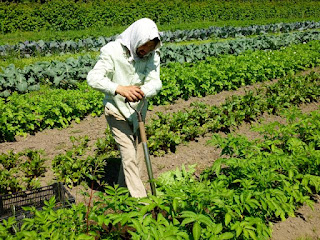Every week throughout the summer we assemble 89 boxes of produce as part of our Community Supported Agriculture program. Subscribers purchase a share of the harvest early in the season and enjoy the veggies we produce throughout the harvest. This post provides some insight into how the boxes are assembled.
Above is command central. Our high tech tracking system involves a clipboard and order sheet with our orders noted. On Sunday and Monday of each week, we assess what produce will be available and assemble a list of box contents and a harvest list.
Jeremy and I alternate responsibilities each week. One week one of us coordinates orders, washing and packing while the other oversees field work. The following week we switch. The photos below show what it's like form the barn point of view -- it obviously leaves out the harvesting.
The first round of harvesting takes place on Monday. Items such as carrots, beets and onions are harvested, washed and packed before being placed in the cooler. Here, Nirmal and Kiran wash carrots for the CSA.
The Tuesday harvest begins at 7:00 a.m. Nirmal and Kiran begin harvesting with the most fragile (i.e. heat sensitive) items. By 8:00 a.m. the first batch of lettuce has arrived for washing and packing.
We wash everything before packing. This helps to remove field heat from the produce, hydrates the greens and makes sure everything is clean.
A case of lettuce ready for the CSA. Everything is packed into boxes and bins and placed on pallets in the cooler. This makes it easier to add each item at a time to the CSA bins when we pack them at the end of the day.
In addition to worrying about the veggies, we also have to make sure we have our packaging ready. Here, Sheila and Kate prepare our CSA bins with labels that note whether the box contains a full share or half-share subscription.
These decals are new, so each week we have to prepare a few more boxes -- not every bin gets returned each week. We have four bins in circulation for each subscription. It's a big investment in packaging to make the CSA run smoothly.
Meanwhile, the harvest continues. Here, Nirmal unloads the cabbage for the boxes.
All of the CSA bins washed and stacked, ready for packing. But we still have some work to do before filling these.
Items like beans and potatoes are weighed out and bagged. This is a time-consuming task.
At around 5 p.m. we begin preparing to pack the boxes. The first set of boxes leave for delivery to Langley at 6 p.m.
Sheila and Kate roll the trolley along as they pack potatoes into the boxes.
We try to place items in the same position in each box to make it easier to double-check that each box is filled properly. Despite this attention to detail, we make the odd mistake. One box was missing its lettuce two weeks ago.
Finally, the boxes are packed and placed on pallets in the cooler. The bins will be loaded onto our truck at 6 a.m. Wednesday morning along with our other deliveries and taken into Vancouver. That's right, amidst all of this, we're also packing other orders.
And so, here's what went into this set of boxes this week:
Each full share received:
- 1 bunch Rainbow Chard
- 1 Red Butter Lettuce
- 1 bunch Rainbow Beets
- 1 lb Yellow Beans
- 1 large Green Cabbage
- 2 lbs Rainbow Carrots
- 1 Long English Cucumber
- 1 bulb Fennel
- 1 bunch Green Onions
- 1 Sweet Onion
- 2 lbs Yukon Gold Potatoes
- 2 small or 1 large Zucchini
Each half-share received:
- 1 bunch Rainbow Beets
- 1/2 lb Green and Yellow Beans
- 1 small Green Cabbage
- 1 lb rainbow Carrots
- 1 Long English Cucumber
- 1 bulb Fennel
- 1 bunch Green Onions
- 1 Sweet Onion
- 2 Patti-Pan Squash
After all of the boxes are packed, there's still an e-mail to go out to subscribers. And while delivery is taking place on Wednesday morning, harvesting continues for the Langley Farmers Market on Wednesday afternoon and the New Westminster Farmers Market on Thursday. Thursday and Friday are harvest days for the weekend markets: Lonsdale and White Rock.
Amidst all of this, we continue planting, weeding, pruning and marketing plus other chores such as milking goats, feeding chickens, cleaning eggs and administrative tasks. The summers are busy, but it's an exciting time when there is so much amazing produce growing and we can put together great boxes for our subscribers.
Interested in subscribing next year? Let us know: glenvalleychris (at) gmail.com.






















































